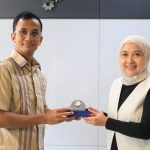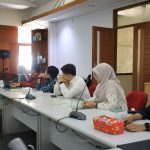Freeing Ideas and Innovations: FTMD Facilitates Students through Engineering Product Design and Prototyping
The annual exhibition of student works, organized by the Faculty of Mechanical and Aerospace Engineering (FTMD) at ITB, is a long-standing mission accomplished by undergraduate students majoring in Mechanical Engineering. The exhibition showcases the product designs created by students as the outcomes of the courses Engineering Product Design (MS3203) and Engineering Product Prototyping (MS4100).
The Prototyping Exhibition serves as a means for students to fulfill their responsibility in completing the design and budgeting of their proposed engineering products. Moreover, the exhibition aims to promote the engineering products developed by students to the general public, with the hope that these products can be further developed by industries, community organizations, or research institutions.
Long before the students showcase their products at the ITB West Hall, the venue for the prototyping exhibition, they go through numerous stages and a lengthy process that spans one year. These processes and preparations are covered in the courses Engineering Product Design and Engineering Product Prototyping.
The Long Process of Engineering Product Design and Prototyping Begins
It all started with Prof. Ir. Djoko Suharto, M.Sc., Ph.D., who sought to connect educational programs with industrial development since 1978. He developed the course Design for Manufacturability, aiming to provide students with a realistic understanding of industry-related problems. Over time, this course has evolved into Engineering Product Design (MS3203) and Engineering Product Prototyping (MS4100).
Dr. Ir. I Wayan Suweca, D.E.A., one of the coordinators of these two courses, explained that the initial concept of both courses involves a two-stage process of engineering product creation.
The first stage is the creation in the mental realm or mental creation. In this stage, students are required to identify ideas or problems around them and find solutions. Students work in groups to explore ideas until they can transform the obtained solutions and innovations into working drawings (blueprints) and cost estimates. This stage is carried out in the Engineering Product Design course (MS3203), which carries a weight of 3 credit hours.
During this stage, students have the freedom to search for problems or needs in society without specific limitations. They are encouraged to find problem ideas through interviews, observations, and other methods. However, the presence of the supervising lecturer serves as a parameter for the planning and creation of the engineering product to be developed in the future. If the scope of the problem or topic is broad, it will be divided into several major sections to be designed by different groups.
Regarding the themes related to engineering products in each year, FTMD lecturers determine them based on current issues. For example, in 2019, the chosen theme was the COVID-19 pandemic, where the designed products focused on prevention or healthcare devices. Additionally, there were recurring products related to agricultural tools, both for post-harvest and pre-harvest purposes. However, the emphasis was always on addressing weaknesses or deficiencies in existing products.
With the same team and supervising lecturers, the process of engineering product creation continues to the next stage, which is the physical creation. In this stage, students start translating their initial design drawings into three-dimensional products. This phase is covered in the Engineering Product Prototyping course (MS4100), which carries a weight of 2 credit hours.
Collaboration with Other Study Programs
Since 2014, several students from the Industrial Engineering Management undergraduate program at the Faculty of Industrial Technology (FTI) have taken the Engineering Product Design course (MS3203), although it is not mandatory for them to proceed to the Engineering Product Prototyping course (MS4100) like the Mechanical Engineering students.
“Students from Fine Arts and Electrical Engineering have also joined this course,” explained Dr. Ir. I Wayan Suweca, D.E.A.

“Example of Product Engineering Design Outcome in the Healthcare Field.”
Evaluation Criteria
The Prototyping Exhibition is not merely a platform for displaying engineering products; it involves several evaluation aspects. These include the background of the ideas, the design process, product performance, and the students’ presentation techniques, all of which are assessed in detail. The highest consideration is given to the functionality of the products created by the students. At the end of the event, FTMD provides appreciation and awards to the best-performing groups.
Besides the products, the individual performance of each student is also evaluated, including their contribution of ideas to the group, the preparation of the final report, teamwork, and other aspects.
Objectives and Benefits for Students
“Students must have the experience of integrating and applying the courses they have taken through the design, development, and production of products at least once during their studies,” explained Dr. Ir. I Wayan Suweca, D.E.A., when asked about the objectives of these two lengthy courses.
Through the application of engineering design principles, students are expected to develop their technical skills, such as determining alternative solutions to problems, selecting materials, analyzing structural strength, determining product layouts, and creating machine drawings. In this stage, students integrate all the knowledge acquired in their previous courses.
In the Engineering Product Prototyping course, students apply knowledge related to the most suitable production/manufacturing processes, determine assembly techniques, and apply geometric tolerances required for product development.
“All these experiences are expected to be valuable when they enter the workforce,” concluded Dr. Ir. I Wayan Suweca, D.E.A.
He hopes that all students taking these courses approach them with seriousness so that the objectives of the courses can be achieved. Furthermore, he hopes that the Prototyping Exhibition will attract external stakeholders, such as industries, the public, or research institutions, to provide support for the successful implementation of these two courses.







